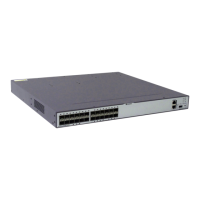The neighboring router ID identifies each mesh group. Several concurrent links are added to a
mesh group. Flooding is implemented once in the group. You can add interfaces that meet the
following conditions to the same mesh group.
l The interfaces belong to the same area and OSPF process.
l The interfaces begin to exchange DD packets.
l The interfaces are connected to the same neighboring switch.
Perform the following steps on the switch running OSPF.
Procedure
Step 1 Run:
system-view
The system view is displayed.
Step 2 Run:
ospf [ process-id ]
The OSPF process view is displayed.
Step 3 Run:
mesh-group enable
The mesh-group function is enabled.
By default, the mesh-group function is disabled.
----End
4.6.9 Setting the Maximum Number of External LSAs in the LSDB
You can set the maximum number of external LSAs in the LDSB to keep a proper number of
external LSAs.
Procedure
Step 1 Run:
system-view
The system view is displayed.
Step 2 Run:
ospf [ process-id ]
The OSPF process view is displayed.
Step 3 Run:
lsdb-overflow-limit number
The maximum number of external LSAs in the LSDB is set.
----End
S6700 Series Ethernet Switches
Configuration Guide - IP Routing 4 OSPF Configuration
Issue 01 (2012-03-15) Huawei Proprietary and Confidential
Copyright © Huawei Technologies Co., Ltd.
115

